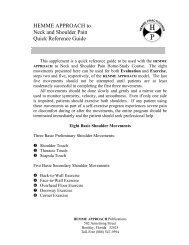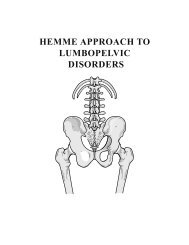HEMME APPROACH TO SOFT-TISSUE THERAPY
HEMME APPROACH TO SOFT-TISSUE THERAPY
HEMME APPROACH TO SOFT-TISSUE THERAPY
Create successful ePaper yourself
Turn your PDF publications into a flip-book with our unique Google optimized e-Paper software.
The difficulty in using this scale is knowing whether to grade a muscle<br />
as normal (5) or good (4). A strong patient with serious disability may<br />
sometimes test higher than a weak patient with a minor disability. A strong<br />
patient can lose a greater percentage of strength than a weak person and still<br />
hold against gravity and give the appearance of normal strength. Bilateral<br />
comparison is one way to cross-check the results of muscle testing.<br />
If only one side of the body is involved, check the muscles on the<br />
impaired side before checking muscles on the opposite side. If the muscles<br />
on the impaired side are the weakest, a grade of 5 for the impaired side may<br />
be too high. If muscles on both sides of the body test the same, a grade of 4<br />
for the impaired side may be too low.<br />
Because of handedness, the tendency to use one hand in preference to<br />
the other, dominant side muscles are normally stronger than weak side<br />
muscles. Since most people are right-handed, the left side testing stronger<br />
than the right side may indicate weakness on the right.<br />
Muscle testing is based on the premise that no two muscles perform<br />
exactly the same function. According to theory, each muscle can be tested<br />
separately if direction of force, amount of force, and position of patient are<br />
correct. The direction of force is normally opposite the direction of pull for<br />
the muscle being tested. Deviation from this direction allows the patient to<br />
substitute other muscles for the muscle being tested. The amount of force<br />
used will vary with size and condition of the patient. Examiners will learn<br />
how much force to use by experience. Since leverage normally favors the<br />
examiner, using too much force is more likely to cause inaccuracy than<br />
using too little force.<br />
Three types of positioning are used in muscle testing: (1) positioning to<br />
prevent substitution, (2) positioning to reinforce fixator muscles, and (3)<br />
positioning to create active insufficiency.<br />
(1) Positioning to Avoid Substitution<br />
Positioning isolates the muscle being tested by using stabilization to<br />
prevent substitution. If the muscle being tested is weak, stabilization<br />
prevents other muscles from contributing to the same movement by not<br />
allowing the body to change position. If the initial body position favors the<br />
34<br />
<strong>HEMME</strong> Approach to Soft-Tissue Therapy









